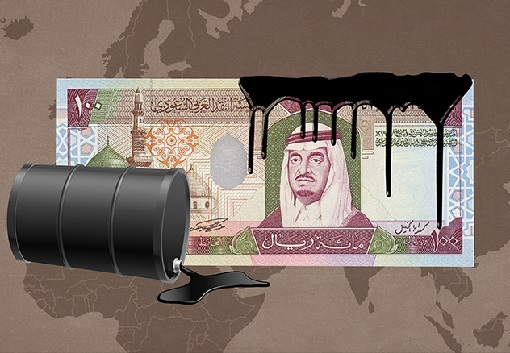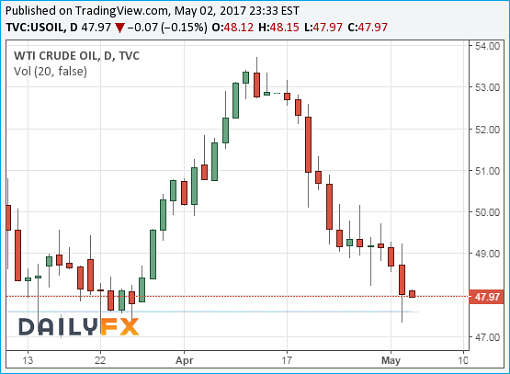Two months ago, we were presented with a chance to witness oil price going down to US$42 a barrel, or lower. The more than 5% plunge on that Wednesday saw the price trading at its lowest for the year 2017 – from a high of US$52.92 to a low of US$50.05 – after the Energy Information Administration reported a ninth straight weekly rise in U.S. crude stockpiles.
Saudi Arabia, of course, wasn’t happy with the sudden price drop. They threw tons of “FUDs” to spook the market. In case you hadn’t a clue what the heck is “FUD”, that’s a gimmick word practiced by IBM salesmen. When those salesmen couldn’t convince the customers to buy, they confuse them with “FUD” – Fears, Uncertainties and Doubts. And it works awesomely well.

After toying with output and exports, Saudi had thrown a third word – supply – into the debate with OPEC members and oil producers. Saudi has often communicated two different sets of output figures to the market: its pumped crude production – which it reports directly to OPEC, and a supply figure – usually leaked to journalists for whatever reasons.
For example, the kingdom told OPEC its production increased to 10.011 million bpd (barrels per day) in February from 9.748 million bpd in January. However, it later issued a statement saying its January supply was higher than output at 9.99 million bpd (meaning it drew oil from storage), while in February supply stood below output at 9.90 million bpd (meaning it moved oil into storage).

What this means is while the market was misled by Saudi into believing the kingdom was producing below its output target in January, it was actually supplying more crude, which it didn’t say publicly. Traders fear that Riyadh would pump more crude – secretly – behind everyone’s back, hence cheating the OPEC’s pledge to reduce a global glut.
But it doesn’t matter if Saudi, or OPEC for that matter, cheats. For the second time for the year 2017, the U.S. crude has broken below US$48 a barrel. The U.S. West Texas Intermediate (WTI) futures and international benchmark Brent crude were both down more than 2%, before a slight recovery.

This round, not even the news of falling production in Russia and OPEC could push the oil price. Traders are more concern about rising output in the United States, Canada and Libya. John Kilduff, founding partner at energy hedge fund Again Capital, and the same person who predicted that the crude oil was heading to US$42 a barrel back in March, is still bearish.
Kilduff pointed to a Bloomberg report that the Libyan prime minister and a rival commander had agreed to set up a power-sharing council. Prime Minister Fayez al-Sarraj and rival Eastern commander Khalifa Haftar agreed to form a council in which they will be members along with the speaker of parliament Aguila Saleh.

Following peace talks in Abu Dhabi, elections will be held 6 months after completion of the deal, which also includes an agreement on dissolving militias and fighting terrorist groups. What this means is the end of turmoil that has devastated Libya since the 2011 uprising. On Monday, Libya’s National Oil Co said its production had risen above 760,000 bpd to its highest since December 2014.
In addition to Libyan output gains, U.S. crude output is at its highest since August 2015, while the Syncrude Canada oil sands project has started shipping crude from its Mildred Lake again after cutting production due to a fire in March. So, OPEC and Russia can cut their production all they want, but they’re fighting an uphill battle against the trio.

If Libya, U.S. and Canada’s production could offset – and even overwhelm – OPEC and Russia’s cut, Saudi Arabia could be in trouble. Already, Roberto Friedlander, head of energy trading at Seaport Global Securities, has raised the possibility that Saudi may be ready to resume its battle for market share with other producers.
Like the same Wednesday back in March, today’s Energy Information Administration stockpiles data at 4:30 p.m. EDT will determine if the crude oil price skyrockets or drops like a rock. Analysts expect a decline of 2.2 million barrels of crude in storage – making it a fourth straight week of declines from a record high reached at the end of March.

Other Articles That May Interest You …
- Oil Going $42 – Speculators Give Up, Saudi Doesn’t Know What To Do
- Oil Below $60 This Year – Saudi Struggles As Shale Drillers Are Back
- A Month Of Asia Tour – King Salman’s Mission & The Real Reason He’s Here
- Congress Rejects Obama’s Veto – Now “Terrorist Sponsor” Saudi’s Assets Can Be Seized
- Cheaper Than Water – This British Bank Thinks Oil Would Go To $10 / Barrel
- Meet United States – The World’s Latest Oil Exporter – After 40 Years
- Here’s Why Oil Above $100 Will Never Happen Again, Ever, Forever!!
- The Glory Days Are Over – OPEC Warlord Saudi Has Started Borrowing
- Saudi’s Past Arrogance & Terrorists Funding – Is This Karma?
- This Country Is So Badly Hit By Oil Prices That Having Sex Is Impossible

|
|
May 3rd, 2017 by financetwitter
|


|

|

|

|

|

|




























Comments
Add your comment now.
Leave a Reply